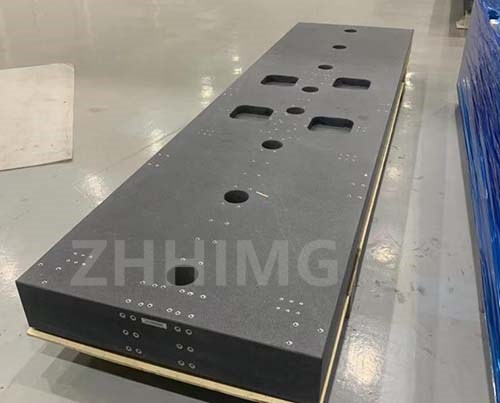In the process of the semiconductor industry moving towards nanoscale manufacturing processes, wafer cutting, as a key link in chip manufacturing, has extremely strict requirements for equipment stability. The granite base, with its outstanding vibration resistance and thermal stability, has become a core component of wafer cutting equipment, providing a reliable guarantee for achieving high-precision and high-efficiency wafer processing.

High damping and anti-vibration characteristics: Safeguarding nano-level cutting accuracy
When the wafer cutting equipment is in operation, the high-speed rotation of the spindle, the high-frequency vibration of the cutting tool, and the environmental vibration generated by the surrounding equipment will all have a significant impact on the cutting accuracy. The damping performance of traditional metal bases is limited, making it difficult to rapidly attenuate vibrations, which leads to micron-level jitter of cutting tools and directly causes defects such as chipped edges and cracks on wafers. The high damping characteristics of the granite base have fundamentally solved this problem.
The internal mineral crystals of granite are closely interwoven, forming a natural energy dissipation structure. When the vibration is transmitted to the base, its internal microstructure can rapidly convert the vibration energy into thermal energy, achieving efficient vibration attenuation. Experimental data show that under the same vibration environment, the granite base can attenuate the vibration amplitude by more than 90% within 0.5 seconds, while the metal base requires 3 to 5 seconds. This outstanding damping performance ensures that the cutting tool remains stable during the nanoscale cutting process, guaranteeing a smooth edge of the wafer cutting and effectively reducing the chipping rate. For instance, in the 5nm wafer cutting process, equipment with a granite base can control the chipping size within 10μm, which is over 40% higher than that of equipment with a metal base.
Ultra-low coefficient of thermal expansion: Resistant to the influence of temperature fluctuations
During the wafer cutting process, heat generated by the friction of the cutting tools, heat dissipation from the long-term operation of the equipment, and changes in the workshop environment temperature can all cause thermal deformation of the equipment components. The coefficient of thermal expansion of metallic materials is relatively high (approximately 12×10⁻⁶/℃). When the temperature fluctuates by 5℃, a 1-meter-long metal base may undergo a deformation of 60μm, causing the cutting position to shift and seriously affecting the cutting accuracy.
The coefficient of thermal expansion of the granite base is only (4-8) ×10⁻⁶/℃, which is less than one-third of that of metal materials. Under the same temperature change, its dimensional change can almost be ignored. The measured data of a certain semiconductor manufacturing enterprise shows that during an 8-hour continuous high-intensity wafer cutting operation, when the ambient temperature fluctuates by 10℃, the cutting position offset of the equipment with a granite base is less than 20μm, while that of the equipment with a metal base exceeds 60μm. This stable thermal performance ensures that the relative position between the cutting tool and the wafer remains precise at all times. Even under long-term continuous operation or drastic changes in environmental temperature, the consistency of cutting accuracy can be maintained.
Rigidity and wear resistance: Ensure the long-term stable operation of the equipment
In addition to the advantages of vibration resistance and thermal stability, the high rigidity and wear resistance of the granite base further enhance the reliability of the wafer cutting equipment. Granite has a hardness of 6 to 7 on the Mohs scale and a compressive strength exceeding 120MPa. It can withstand the tremendous pressure and impact force during the cutting process and is not prone to deformation. Meanwhile, its dense structure endows it with excellent wear resistance. Even during frequent cutting operations, the surface of the base is not prone to wear, ensuring that the equipment maintains high-precision operation for a long time.
In practical applications, many wafer manufacturing enterprises have significantly improved product yield and production efficiency by adopting cutting equipment with granite bases. Data from a globally leading foundry shows that after introducing granite base equipment, the wafer cutting yield has increased from 88% to over 95%, the equipment maintenance cycle has been extended by three times, effectively reducing production costs and enhancing market competitiveness.
In conclusion, the granite base, with its excellent vibration resistance, thermal stability, high rigidity and wear resistance, provides comprehensive performance guarantees for wafer cutting equipment. As semiconductor technology advances towards higher precision, granite bases will play a more significant role in the field of wafer manufacturing, promoting the continuous innovative development of the semiconductor industry.
Post time: May-20-2025

